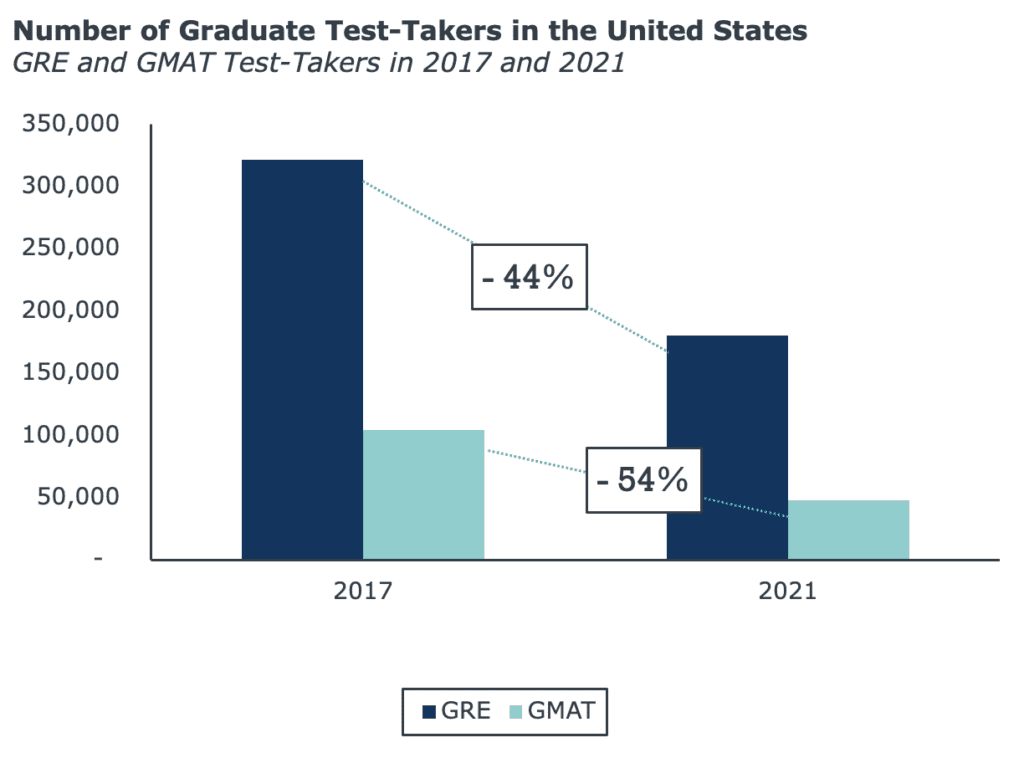Why it’s so hard to find enough domestic leads for online graduate and adult programs
In my conversations about recruitment strategy with graduate and adult enrollment leaders, I often hear the same challenge: they have more international leads than they know what to do with, but they’re struggling to find enough quality domestic leads. Pandemic-era enrollment trends, especially the boom in online graduate programs, have exacerbated many barriers to international enrollment. Catalyzed by the sudden rush online, many institutions have become more focused on the growth of their online programs post-COVID, but many of these programs can’t accommodate international students due to residency requirements. This leaves enrollment executives wondering 1) whether international applicants will get to campus, 2) how they can sustain their online enrollment targets, and 3) how to offset that risk with domestic students.
In this environment, it’s important for institutions to adapt their strategy to recruit more domestic students to attempt to fill their online programs and meet enrollment goals. But why does it seem so hard to find them?
Stealth shopping behaviors increased 300% from 2012 to 2022.
One factor making students more challenging to find is the staggering spike in domestic stealth shopping over the last decade. Our research shows that students are increasingly likely to conduct program research independently, meaning you may not know about them until they apply. This presents a major challenge for enrollment leaders trying to predict their class size, especially at the top of the funnel. However, just because these students are “silent” doesn’t mean they aren’t using your institution’s digital resources on their own time. Thirty-four percent of domestic students surveyed in our most recent Adult Learner Survey said they used institutions’ .edu sites while researching potential programs, making it the second most popular source among survey respondents.
-
#2
Institutions’ websites were the second-most popular educational search source among surveyed adult students.
Today’s consumer sees 4,000 brands a day, and it’s tough to stand out.
Unfortunately, we know that simply having a digital presence isn’t enough to break through to a potential student, especially here in the U.S. Though the average time people spend online has increased globally, Americans spend the most time online by far, with the average consumer spending over seven hours per day on the internet.
Every day, U.S. consumers are confronted with a huge number of logos, advertisements, and product information, making standing out from other institutions—and other businesses in general—a challenge. On top of that, the surge in online graduate and adult programs means there are more programs than ever to compete with: for example, the number of accredited U.S. schools offering an online MBA increased 85% between the 2016-17 and 2020-21 school years.
Do you know how to test marketing messaging among your target audience?
-
7 hours...
and 5 minutes: Average time Americans aged 16 to 64 spend online per day.
Over a quarter of domestic students have no plan to take a graduate admissions test.

The number of domestic students taking the GMAT and the GRE has significantly dropped since 2017. Notably, many institutions who chose to become test-optional at the height of the pandemic are choosing to keep those policies in place, which helps explain why over 25% of the students who participated in our Adult Learner Survey said they have no plan to take a graduate admissions test. This reinforces the need to have a diversified lead generation strategy that doesn’t over-rely on one source. While test-taker lists have been traditionally reliable lead sources, they may not supply the lead volume that they have in the past.
Learn 3 key takeaways about the GMAT focus edition
What can enrollment leaders do about it?
It’s clear that finding domestic students for your graduate and adult programs requires a robust and diversified lead generation strategy. Tactics like the ones below can help you begin to identify and engage prospective students effectively.
1. To engage those students looking at your .edu site, ensure that your website serves as an on-ramp to discovery. Make sure that it is easy to navigate and answers crucial questions about cost, program duration, and flexibility that graduate and adult students are seeking.
2. Stay abreast of consumer marketing tactics that are proving effective outside of higher education, such as gamification, and consider leveraging them for yourself.
3. Lastly, diversify your lead generation sources to avoid over-relying on any one source to fill your class. Incorporating high-intent lead sources, such as Appily Advance, can deliver you leads who are interested in a program like yours, and may have a higher probability of applying.
As global conditions continue to fluctuate, so will the state of international lead generation. Regardless of the future, bolstering your domestic lead generation efforts for your online programs will help ensure that your enrollment numbers remain steady regardless of these global changes.

More Blogs

Adult learners: who they are and what they want from college

4 questions domestic students will ask before applying to your graduate program
